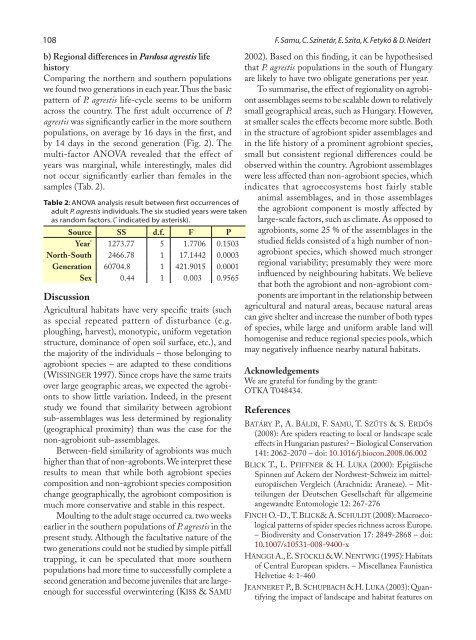Samu F, Szinetár C, Szita E, Fetykó K & Neidert D - European ...
Samu F, Szinetár C, Szita E, Fetykó K & Neidert D - European ...
Samu F, Szinetár C, Szita E, Fetykó K & Neidert D - European ...
You also want an ePaper? Increase the reach of your titles
YUMPU automatically turns print PDFs into web optimized ePapers that Google loves.
108 F. <strong>Samu</strong>, C. <strong>Szinetár</strong>, E. <strong>Szita</strong>, K. <strong>Fetykó</strong> & D. <strong>Neidert</strong><br />
b) Regional differences in Pardosa agrestis life<br />
history<br />
Comparing the northern and southern populations<br />
we found two generations in each year. Thus the basic<br />
pattern of P. agrestis life-cycle seems to be uniform<br />
across the country. The first adult occurrence of P.<br />
agrestis was significantly earlier in the more southern<br />
populations, on average by 16 days in the first, and<br />
by 14 days in the second generation (Fig. 2). The<br />
multi-factor ANOVA revealed that the effect of<br />
years was marginal, while interestingly, males did<br />
not occur significantly earlier than females in the<br />
samples (Tab. 2).<br />
Table 2: ANOVA analysis result between first occurrences of<br />
adult P. agrestis individuals. The six studied years were taken<br />
as random factors. ( * indicated by asterisk).<br />
Source SS d.f. F P<br />
Year * 1273.77 5 1.7706 0.1503<br />
North-South 2466.78 1 17.1442 0.0003<br />
Generation 60704.8 1 421.9015 0.0001<br />
Sex 0.44 1 0.003 0.9565<br />
Discussion<br />
Agricultural habitats have very specific traits (such<br />
as special repeated pattern of disturbance (e.g.<br />
ploughing, harvest), monotypic, uniform vegetation<br />
structure, dominance of open soil surface, etc.), and<br />
the majority of the individuals – those belonging to<br />
agrobiont species – are adapted to these conditions<br />
(WISSINGER 1997). Since crops have the same traits<br />
over large geographic areas, we expected the agrobionts<br />
to show little variation. Indeed, in the present<br />
study we found that similarity between agrobiont<br />
sub-assemblages was less determined by regionality<br />
(geographical proximity) than was the case for the<br />
non-agrobiont sub-assemblages.<br />
Between-field similarity of agrobionts was much<br />
higher than that of non-agrobonts. We interpret these<br />
results to mean that while both agrobiont species<br />
composition and non-agrobiont species composition<br />
change geographically, the agrobiont composition is<br />
much more conservative and stable in this respect.<br />
Moulting to the adult stage occurred ca. two weeks<br />
earlier in the southern populations of P. agrestis in the<br />
present study. Although the facultative nature of the<br />
two generations could not be studied by simple pitfall<br />
trapping, it can be speculated that more southern<br />
populations had more time to successfully complete a<br />
second generation and become juveniles that are largeenough<br />
for successful overwintering (KISS & SAMU<br />
2002). Based on this finding, it can be hypothesised<br />
that P. agrestis populations in the south of Hungary<br />
are likely to have two obligate generations per year.<br />
To summarise, the effect of regionality on agrobiont<br />
assemblages seems to be scalable down to relatively<br />
small geographical areas, such as Hungary. However,<br />
at smaller scales the effects become more subtle. Both<br />
in the structure of agrobiont spider assemblages and<br />
in the life history of a prominent agrobiont species,<br />
small but consistent regional differences could be<br />
observed within the country. Agrobiont assemblages<br />
were less affected than non-agrobiont species, which<br />
indicates that agroecosystems host fairly stable<br />
animal assemblages, and in those assemblages<br />
the agrobiont component is mostly affected by<br />
large-scale factors, such as climate. As opposed to<br />
agrobionts, some 25 % of the assemblages in the<br />
studied fields consisted of a high number of nonagrobiont<br />
species, which showed much stronger<br />
regional variability; presumably they were more<br />
influenced by neighbouring habitats. We believe<br />
that both the agrobiont and non-agrobiont components<br />
are important in the relationship between<br />
agricultural and natural areas, because natural areas<br />
can give shelter and increase the number of both types<br />
of species, while large and uniform arable land will<br />
homogenise and reduce regional species pools, which<br />
may negatively influence nearby natural habitats.<br />
Acknowledgements<br />
We are grateful for funding by the grant:<br />
OTKA T048434.<br />
References<br />
BATÁRY P., A. BÁLDI, F. SAMU, T. SZŰTS & S. ERDŐS<br />
(2008): Are spiders reacting to local or landscape scale<br />
effects in Hungarian pastures? – Biological Conservation<br />
141: 2062-2070 – doi: 10.1016/j.biocon.2008.06.002<br />
BLICK T., L. PFIFFNER & H. LUKA (2000): Epigäische<br />
Spinnen auf Ackern der Nordwest-Schweiz im mitteleuropäischen<br />
Vergleich (Arachnida: Araneae). – Mitteilungen<br />
der Deutschen Gesellschaft für allgemeine<br />
angewandte Entomologie 12: 267-276<br />
FINCH O.-D., T. BLICK& A. SCHULDT (2008): Macroecological<br />
patterns of spider species richness across Europe.<br />
– Biodiversity and Conservation 17: 2849-2868 – doi:<br />
10.1007/s10531-008-9400-x<br />
HÄNGGI A., E. STÖCKLI & W. NENTWIG (1995): Habitats<br />
of Central <strong>European</strong> spiders. – Miscellanea Faunistica<br />
Helvetiae 4: 1-460<br />
JEANNERET P., B. SCHUPBACH & H. LUKA (2003): Quantifying<br />
the impact of landscape and habitat features on
















